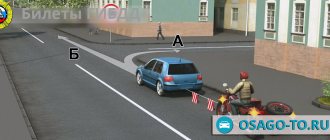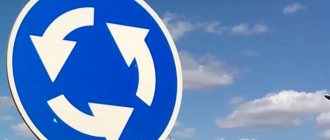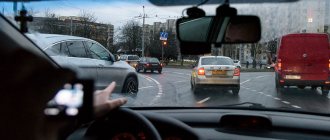Useful changes
There are several changes that should make road traffic safer. So, clause 154 was changed in the rules and finally it was prohibited for persons who did not have a license to drive a moped on the road.
154. It is prohibited for persons younger than:
154.1. fourteen years old - bicycle (except for pedestrian and residential areas, sidewalks, bicycle and pedestrian paths);
154.2. sixteen years old - moped (except for pedestrian and residential areas).
154. Persons under fourteen years of age are prohibited from driving a bicycle on the road unless accompanied by an adult (except for pedestrian and residential areas, sidewalks, bicycle and pedestrian paths)
In addition, clause 77, which officially allowed vehicles to move in one lane towards each other, was removed.
77. On a two-way road that has three lanes marked with horizontal road markings (with the exception of horizontal road markings 1.9), of which the middle lane is used for traffic in both directions, changing to this lane is only allowed for overtaking, avoiding obstacles, left turn or U-turn, and the left turn or U-turn must be made from this lane. Changing into the oncoming far left lane is prohibited.
— We changed the requirement of paragraph 5 of marking 1.7, according to which previously all drivers at intersections without a roundabout were violators. These are intersections with broken lines. This blunder has been known since 2006, that is, from the time it was introduced. It took 13 years to fix it, but even now it was not without incident. Why write about other intersections if there is clause 60, which already prohibits changing lanes at any intersection other than a roundabout.
5. Marking lines 1.5 - 1.8 are allowed to be crossed from any side, except at intersections where roundabout traffic is not organized. (as amended by Decree of the President of the Republic of Belarus dated October 18, 2007 N 526)
5. Marking lines 1.5, 1.6, 1.8 are allowed to be crossed from any side. Marking line 1.7 can be crossed on either side at roundabouts; at other intersections it is prohibited to cross to change lanes from one lane to another.
Who's in charge?
“I don’t understand why novice drivers are afraid of the ring like fire. In fact, if we mentally divide the ring into four parts and take the section where cars enter the circle, we will see the most ordinary T-shaped intersection. The corresponding rules apply with the only caveat - turning left and making a U-turn are impossible,” says Mikhail Gurnovich, a teacher at the BSATU driving school.
People often argue about who should give way to whom at a roundabout. The capital's drivers are accustomed to the fact that the ring is the main thing. Therefore, sometimes they are perplexed - why is everything different? But the fact is that the ring may not be the main thing.
In Minsk, almost all the rings are major. Before entering the intersection there is a priority road sign “Give way” or “Driving without stopping is prohibited”, that is, those who want to enter the circle must give way to everyone moving along the circle.
Below these signs there will be a 7.13 Main Road Direction sign which shows where the main road goes. As a rule, on it the circle will be highlighted with a thick line, and all the entrances will be highlighted with a thin line. But it also happens differently if the main road changes direction at the roundabout. In this case, the thick line will follow the corresponding trajectory.
If there are no priority signs in front of the intersection, then the ring is not a main road. “This means that at a roundabout intersection the rules for driving through unmarked intersections will apply, that is, we pass through obstacles.
In this case, cars moving in a circle must give way to those entering the circle, who will be an obstacle for them on the right. We follow the same rule when changing lanes from one lane to another within a roundabout intersection,” explains the teacher.
Driving around roundabouts
However, according to Alexander Konoplitsky, many points were missed when developing the new edition of the traffic rules.
- First of all, you need to pay attention to roundabouts - paragraph 40. Imagine a simple situation... Drivers approached a cross-shaped intersection and stopped at a red traffic light. There are no signs before the intersection. Then the red traffic light continues to light, but an additional section of the traffic light “to the right” is turned on. Which driver can move on? You will say that only the driver in the far right lane can turn right, and you will be absolutely right.
According to clause 40, when the additional section of the traffic light is turned on, movement is allowed only in the direction indicated by the arrow.
— Now the situation is the same, only the traffic light is installed in front of the roundabout. The same drivers stopped in the same lanes at a red traffic light, but when the additional section of the traffic light turns on, not only the cars in the first lane, but also the cars in the second and third lanes go to the right. What's the result? At a controlled roundabout, when the main traffic light is red and the additional “right” section is on, everyone goes wherever they want... Why? Is there really such a rule that a pile of earth piled in the middle of an intersection allows you to drive straight, left, and even make a U-turn if the main red signal and the additional “right” section are on? - the expert is surprised.
It is not clear for what reason and by whom, but the rule of moving to an additional section at roundabouts was tacitly abolished. Maybe that’s why we have so many accidents at roundabouts, and many drivers are afraid of roundabouts and try to avoid them.
Minsk traffic police: when entering the roundabout, turn on the RIGHT turn signal
At the intersection itself, traffic moves counterclockwise. Regarding the initial movement of a driver approaching a roundabout in any lane, traffic on the roundabout goes from left to right. But even here on the forum ( comments Tut.by, approx. AvtoGrodno
) it has been suggested that this is a curve in the road because there are solid marking lines there that indicate traffic lanes. What, solid markings cannot indicate traffic lanes at an intersection? Maybe. The traffic rules say this. Horizontal markings 1.1 are used, among other things, to mark the boundaries of traffic lanes on dangerous sections of the road. It doesn’t say there that such areas can only be outside intersections? A crossroads is an intersection of roads. There could be intermittent markings, but this area is dangerous and the possibility of an accident must be excluded. Therefore, the markings are continuous - it prohibits changing lanes, which is permitted by traffic rules at a roundabout intersection, paragraph 60. And in the place where changing lanes is allowed, the markings are intermittent.
We recommend reading: Where should a fence be classified as real or movable property?
And so, the main dispute arises precisely because of the inclusion of the right direction indicator when approaching an intersection at which a roundabout is organized. Why did drivers change lanes and immediately turn left? Because many people, just as they didn’t know the Rules, still don’t know them, but act based on their own logic and faith
The fact is that there is no intersection before the lanes along which the circle moves, but there is a bend in the road and they see the exit, which is at an acute angle to the lanes of the circle.
Overtaking at intersections
The first part of paragraph 111 clearly states that when turning left or making a U-turn, the driver of a vehicle is obliged to give way to oncoming vehicles moving straight or to the right on an equivalent road.
"111. When turning left or making a U-turn, the driver of the vehicle is obliged to give way to oncoming vehicles moving straight or to the right on an equivalent road, and to a passing tram...”
— I don’t want to dispute this provision in any way, but let’s look at clause 111 in combination with clause 96.2 of the traffic rules, which says that overtaking is prohibited at marked and (or) controlled intersections. Let's consider the simplest traffic situation that constantly arises on the highways. A country road with one lane in each direction. Two cars, one after the other, approach a small intersection, in front of which there are no signs in their direction of travel. There is also no traffic light at the intersection. The first car begins to turn left, and at this time the rear one overtakes the first car. A collision occurs. Who is to blame? - asks Alexander Konoplitsky.
In this situation, each of the drivers, when making a left turn and overtaking, respectively, and complying with the requirements of the relevant articles of the traffic rules, had an advantage when performing the maneuver. Thus, the driver of the first car, when making a left turn maneuver in accordance with the requirements of clause 111 of the Traffic Regulations, was obliged to give way only to vehicles moving from the opposite direction straight or to the right. The requirement to give way to vehicles moving behind in the same direction is not provided for by the provisions of clause 111 of the Traffic Regulations.
Photo: Sponchia / pixabay.com
The driver of the second car, moving behind the first in the same direction as him, in accordance with the provisions of clause 96.2 of the Traffic Regulations, had the right to overtake at an unmarked intersection. The relevant provisions of the traffic rules do not provide for any requirement to give way to cars moving ahead when overtaking. Thus, before the accident, none of the drivers violated the rules. So it turns out that a collision occurred, but there were no perpetrators.
— Previously, overtaking was prohibited at all intersections. Now it is allowed on undesignated and unregulated markets. For what? To increase the number of accidents? There are examples when anyone is “assigned” to blame - both the one who overtook and the one who was overtaken. It all depends on what the inspector decides. It is necessary to return to the previous definition and prohibit overtaking at all intersections, the expert is sure.
Discussing traffic rules with Yuri Krasnov
According to the traffic rules of Belarus (clause 63. Chapter 9. “Maneuvering”): Before making a U-turn, turning left or right, the driver is obliged, without creating an obstacle or danger to the movement of other road users, to take the appropriate extreme position on the roadway intended for traffic in in this direction, except for cases when the turn WHEN ENTERING AND LEAVING AN INTERSECTION is made in those places WHERE CIRCULAR TRAFFIC IS ORGANIZED, as well as in places where the direction of movement along the roadway (intersection) is determined by road signs and (or) a horizontal road markings.
We recommend reading: Benefits for combat veterans on transport tax in the Stavropol Territory 2021
According to the Russian Traffic Regulations (subclause 8.5. Chapter 8. “Starting movement, maneuvering”): Before turning right, left or making a U-turn, the driver is obliged to take the appropriate extreme position in advance on the roadway intended for traffic in a given direction, except in cases where a turn is being made. ENTERING AN INTERSECTION where there is a roundabout.
Where do traffic rules apply?
For many years, traffic rules have been in force only on the roads of the Republic of Belarus. Clause 2.78 defines what is included in the road and lists all the elements that make up the road. It is clearly visible that the road does not include the adjacent territory, a path for riders, or a separate bicycle path.
In order to find out what the adjacent territory is, let us turn to paragraph 2.53:
“2.53. Adjacent territory is the territory immediately adjacent to the roadway, not intended for through passage, on which courtyards, areas specially designated for parking vehicles, gas stations, construction sites and other objects are located.”
Thus, all construction sites, courtyards, gas stations (gas stations) and car parking areas are adjacent areas and are not part of the road. Accordingly, traffic regulations in such territories do not apply to road users.
Repetitions in traffic rules
“Clause 88. In populated areas, vehicles are allowed to move at a speed of no more than 60 km/h, and for those towing motor vehicles - no more than 50 km/h, in residential and pedestrian areas, in adjacent areas - no more than 20 km/h, in restricted areas maximum speed - no more than the value indicated on the corresponding road sign.
— This paragraph states that in residential and pedestrian areas, as well as in adjacent areas, the speed of the vehicle you are driving should be no more than 20 km/h. And if you drive at a higher speed, will you break it? Undoubtedly! But for some reason there are two traffic rules at once - 88 and 137.1! - says Alexander Konoplitsky.
"137. In residential and pedestrian zones, and in the adjacent territory, drivers of motor vehicles are prohibited from:
137.1. driving at a speed of more than 20 km/h.”
It turns out that if you exceed the speed limit once, you violate two traffic rules at once and can receive two fines on a completely legal basis! There should not be such “repetitions”. They do not lead to improved safety, but only worsen already confusing traffic rules.
Stop by transport inspection
— Clause 9.1 states that Transport Inspectorate employees have the right to stop vehicles by turning on a blue beacon using a display and (or) a loud-speaking device. What should a driver do when he sees a moving car with blue lights on? Clause 26 of the Traffic Regulations directly speaks about the actions of the driver in such a situation. This clause does not require the mandatory stopping of the vehicle you are driving when a car approaches with a blue beacon on. Thus, fulfilling the requirements of paragraph 26 of the traffic rules, the driver has the right not to stop when a Transport Inspectorate vehicle approaches with a blue beacon on, the expert explains.
Remove “recommended” traffic rules
— What is the point of the rules if their implementation is not mandatory, but recommended? This means that you don't have to do this.
"52. It is recommended to turn on the hazard warning lights when the vehicle is moving in reverse.”
Paragraph 29 contains the word “may”:
"29. To attract the attention of road users, drivers of operational vehicles may sound a special sound signal.”
— Based on this point, the driver may or may not turn on a special signal. Regardless of whether the signal is on or not, drivers of other vehicles do not have any additional responsibilities when it is turned on. This clause cannot be violated. Such rules only increase the volume of traffic regulations and do not in any way affect road safety. The words “may” and “recommended” should not be in traffic rules, since they relax road users and give rise to the opinion that compliance with traffic rules is not mandatory, the expert is convinced.
Photo: Oleg Kindar, TUT.BY
There are paragraphs that contain phrases like “...obligated taking into account the road traffic situation...(95).” The word “obliged” implies the unconditional implementation of this paragraph, and “taking into account the road and transport situation” implies that it is not at all necessary to do this, but only if there is such an opportunity. So is it necessary or possible?
There was something funny too. For example, clause 200 of the traffic rules.
“A horse-drawn vehicle must be equipped with white reflectors at the front and red at the rear, and have a serviceable parking brake and wheel chocks as required by the design.”
— Regarding the wheel chocks and the hand brake on the cart, I would like to ask - has anyone ever seen such a cart? Haven't you met? But this is how it should be according to traffic rules! Nobody knows what a parking brake device—a “handbrake”—should look like on a cart. This is another traffic rule that exists only on paper and inflates the already voluminous traffic rules,” says Alexander.
And in paragraph 153 they even managed to forget about cases, which no one has canceled yet...
153. A cyclist and moped driver are prohibited from:
153.1. use technically faulty bicycles and mopeds, as well as those equipped in violation of the requirements of technical regulatory legal acts and established requirements ;
— It seems to me that “established requirements” would be correct, especially since this was the case before the change.
A sleeping policeman is an obstacle to traffic
In accordance with paragraph 2.52 of the Traffic Regulations, an obstacle to traffic is any object located in the path of movement and in front of which the driver is forced to reduce speed, go around or stop. What should a driver do when an obstacle is detected?
"34. If an obstacle is detected or created on the road that creates a danger to traffic, road users are obliged to:
34.1. take measures to eliminate it;
34.2. if it is impossible to remove the obstacle, mark it in accordance with these Rules or in another way that ensures road safety, and then report the obstacle to the police or road maintenance or utility service.”
— And in accordance with the definition of paragraph 2.78 of the Traffic Regulations, an artificial hump is not an element of the road, that is, it is an obstacle to traffic. Thus, according to the traffic rules, having approached an artificial bump, the driver must take measures to eliminate this bump, that is, remove it. If this is not possible, then you must report it to the police or road maintenance or utility service. It’s interesting that the police will answer your call with something like the following: “Hello. I used a crowbar to pry at the artificial bump, but I couldn’t remove it. I’m telling you, come…” the expert says.
Rules for driving roundabouts in Belarus
Before making a U-turn, turning left or right, the driver is obliged, without creating an obstacle or danger to the movement of other road users, to take the appropriate extreme position on the roadway intended for traffic in a given direction, except for cases where the turn is when entering or exiting an intersection. It is carried out in those places where roundabout traffic is organized, as well as in places where the direction of movement along the roadway (intersection) is determined by road signs and (or) horizontal road markings (traffic rules clause 63.).
We recommend reading: Report on the production practice of a construction organization economist 2021
It is also useful to remember the exit when choosing an entry lane to the roundabout. As an example, let's take a classic intersection with a three-lane roundabout. When the driver needs to take the first exit, it would be wise to choose the right lane. If you need a second exit, then it is better to choose the middle lane. And in order to take the third exit, choose the left lane on the roundabout.










